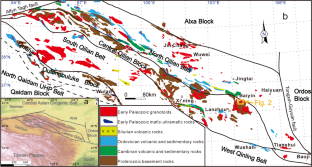International Journal of Earth Sciences ( IF 2.3 ) Pub Date : 2024-04-09 , DOI: 10.1007/s00531-024-02406-w He Yang , Biji Luo , Hongfei Zhang , Wenjiao Xiao , Lu Tao , Zhong Gao , Liqi Zhang , Xi Chen

|
Granite genesis is crucial to understanding the evolution of continental crust, yet many concerns about granite genesis remain not well answered, such as whether I-type granite contains metasedimentary components, what controls granite compositional diversity, and how granitic plutons are constructed. To explore these issues, we conducted a detailed study on the two-mica plagiogranite, tonalite, and biotite plagiogranite units of the Wujinxia composite pluton in the eastern Qilian orogen, NE Tibetan Plateau. These units comprise two-mica plagiogranite, tonalite (with diorite enclave), and biotite plagiogranite. Zircon U–Pb data reveal that three granitic units formed at ~ 487 Ma, ~ 464 Ma, and ~ 430 Ma, respectively. Magmatic and xenocrystic garnet were identified from the tonalite and biotite plagiogranite, respectively. The two-mica plagiogranite, tonalite, and biotite plagiogranite all belong to low-K series rocks (K2O/Na2O = 0.10–0.26), and were derived from deep crustal sources mainly consisting of juvenile mafic rocks, with involvement of minor metasedimentary rocks in the magma sources of the two-mica plagiogranite and tonalite. The diorite enclave within the tonalite was probably derived from an enriched mantle-derived basaltic magma. Mineral compositions, thermobarometric calculations, and whole-rock geochemical data indicate that the low-K intrusive units of the Wujinxia composite pluton resulted from multiple magmatic systems at different depths. The results suggest that I-type granites can contain metasedimentary components by partial melting of a mixed crustal source, and high-Mn content helps the preservation of high-Ca garnet within such rocks. For a composite pluton spanning a large compositional variation, its compositional diversity is jointly controlled by magma source composition, melting condition and thermal evolution of individual magma pulses, and the resulted assembly style during pluton construction.
Graphical abstract
中文翻译:

青藏高原东北部祁连造山带东部多处低钾花岗岩岩浆的生成:对花岗岩成因和岩体构造的影响
花岗岩成因对于理解大陆地壳的演化至关重要,但关于花岗岩成因的许多问题仍然没有得到很好的解答,例如I型花岗岩是否含有变沉积成分、控制花岗岩成分多样性的因素以及花岗岩岩体是如何构造的。为了探讨这些问题,我们对青藏高原东北部祁连造山带东部乌金峡复合岩体的二云母斜长花岗岩、英云母斜长花岗岩和黑云母斜长花岗岩单元进行了详细研究。这些单元包括二云母斜长花岗岩、英闪长岩(含闪长岩包体)和黑云斜长花岗岩。锆石 U-Pb 数据显示,三个花岗岩单元分别形成于~ 487 Ma、~ 464 Ma 和~ 430 Ma。分别从英云长岩和黑云斜长花岗岩中鉴定出岩浆石榴石和异晶石榴石。二云母斜长花岗岩、英云母斜长花岗岩、黑云母斜长花岗岩均属于低钾系岩石(K 2 O/Na 2 O=0.10~0.26),来源于以新生镁铁质岩为主的深部地壳物源,参与了二云母斜长花岗岩和英闪长岩岩浆源中的小型变沉积岩。英闪长岩内的闪长岩包体可能源自丰富的地幔玄武质岩浆。矿物成分、温压计算和全岩地球化学数据表明,乌锦峡复合岩体的低钾侵入单元是由不同深度的多个岩浆系统形成的。结果表明,I型花岗岩可能因混合地壳来源的部分熔融而含有变沉积成分,高锰含量有助于此类岩石中高钙石榴石的保存。对于成分变化较大的复合岩体,其成分多样性受到岩浆源成分、单个岩浆脉冲的熔融条件和热演化以及岩体构造过程中所形成的组装样式共同控制。



























 京公网安备 11010802027423号
京公网安备 11010802027423号